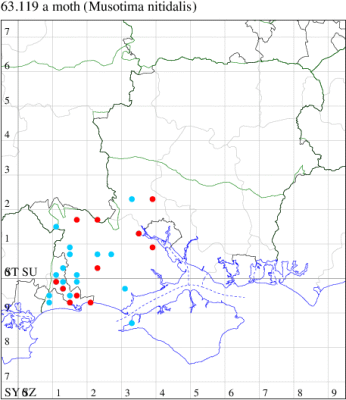2021 Annual Report for: Crambidae / Musotiminae
For species seen in 2021 that had less than or equal to 100 records, full details are included; for more common species, the earliest, latest and highest count by vice-county are shown. The narrative for each species is taken from the main Hantsmoths website, and it is possible that some information on abundance and occurrence can get out of date, as it is impossible to keep up with all changes; however it should give a good introduction to each species. The tables in each species account summarise the previous status, and that for the current year.
For the maps, all records prior to 2021 are shown by a blue dot (the larger the dot, the more recent), with the current year's records shown in red. As previous records are superimposed on any report for 2021, new sites have greater emphasis (i.e. will show as 'more red').
In the species accounts, an asterisk next to a location indicates a new 10km square record; earliest ever dates are highlighted in orange, and latest ever in red. Initials in the species accounts refer to the recorders listed here. Please get in touch if you identify any omissions or errors, in particular if you have records that have yet to be submitted. Details of how to submit records can be found here.
63.119 [B&F: 1355a] Musotima nitidalis (Walker, [1866]) - Adventive
First trapped at Merritown Heath, Dorset on 11 August 2009 by Mike Jeffes and David Evans, and identified at the BENHS Exhibition that year by Martin Honey (BMNH) as the present species, a native of New Zealand which feeds on various fern species. Certainly introduced by the horticultural trade, since 2013 it has since spread widely from the original location across southern England, but also as far as East and West Sussex, and Harlow in Essex. It reached the Isle of Wight in October 2015 (interestingly, this came before it was seen in Hampshire 'proper', when one was found in Sandleheath, New Forest in November 2016; there were no further Wight records until 2022). By 2021 it was reported as abundant in places in the New Forest around bracken, and reached as far east as Fareham in 2023, this year also seeing the first North Hampshire with one in Andover in October. Unmistakable. The food plant in the British Isles appears to be principally Bracken.
Records prior to 2021
| Vice County | #Records | #Individuals | First Record | Last Record |
|---|---|---|---|---|
| 10 | 1 | 1 | 2015 | 2015 |
| 11 | 104 | 158 | 2009 | 2020 |
2021 records
| Vice County | #Records | #Individuals | Max Quantity |
|---|---|---|---|
| 11 | 22 | 29 | 7 |

Records by year
Records by week (adult)
Records by week (larval)
Record Details
VC11: Woodgreen, one, field observation, flying around bracken mid afternoon, 09 Sep (SAC); Burley, NF, one, 18 Sep (NDP); Busketts Wood, NF, present, field observation, 06 Aug; Franchises Wood, NF, present, field observation, hundreds flying around Bracken at night, 22 Oct (RBW); Marchwood, one, 07 Oct (CTha); Totton, one, 11 Sep; one, 27 Oct (LHan); Romsey*, one, 25 Oct (NRJ); Merritown Heath, seven, 28 May; present, 10 Jun (DFoo); Hurn, one, 05 Jun; one, 06 Aug; three, 10 Aug; one, 16 Aug; one, 06 Sep; two, 06 Oct; one, 18 Oct; two, 19 Oct; one, 01 Nov (MJef); Tuckton, Christchurch, one, 24 Sep (APar); Burton, nr Christchurch, one, 17 Aug (JStw); Highcliffe, one, 07 Oct (NMat)